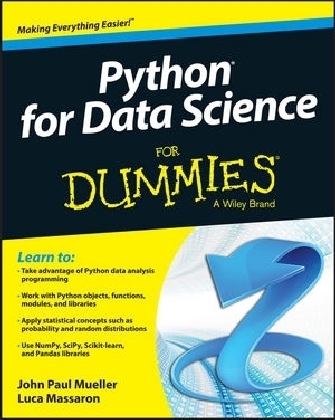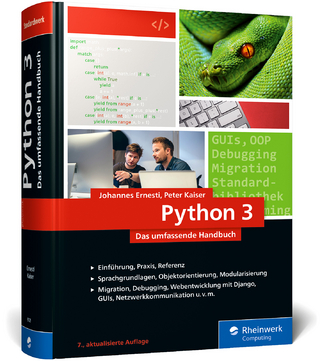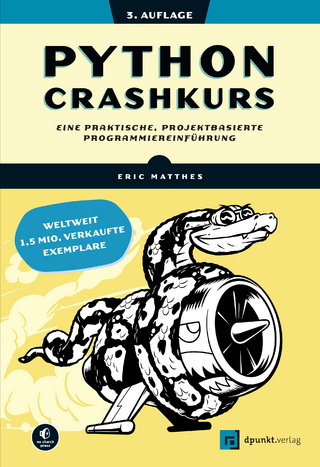
Python for Data Science For Dummies
John Wiley & Sons Inc (Verlag)
978-1-118-84418-2 (ISBN)
- Titel erscheint in neuer Auflage
- Artikel merken
Unleash the power of Python for your data analysis projects with For Dummies! Python is the preferred programming language for data scientists and combines the best features of Matlab, Mathematica, and R into libraries specific to data analysis and visualization. Python for Data Science For Dummies shows you how to take advantage of Python programming to acquire, organize, process, and analyze large amounts of information and use basic statistics concepts to identify trends and patterns. You ll get familiar with the Python development environment, manipulate data, design compelling visualizations, and solve scientific computing challenges as you work your way through this user-friendly guide.
* Covers the fundamentals of Python data analysis programming and statistics to help you build a solid foundation in data science concepts like probability, random distributions, hypothesis testing, and regression models * Explains objects, functions, modules, and libraries and their role in data analysis * Walks you through some of the most widely-used libraries, including NumPy, SciPy, BeautifulSoup, Pandas, and MatPlobLib Whether you re new to data analysis or just new to Python, Python for Data Science For Dummies is your practical guide to getting a grip on data overload and doing interesting things with the oodles of information you uncover.
John Paul Mueller, consultant, application developer, writer, and technical editor, has written over 600 articles and 97 books. His topics range from programming to home security. Luca Massaron is a data scientist and a research director specializing in multivariate statistical analysis, machine learning, and customer insight. He is a pioneer of Web audience analysis in Italy and was named one of the top ten data scientists at competitions by kaggle.com.
Introduction 1 About This Book 1 Foolish Assumptions 2 Icons Used in This Book 3 Beyond the Book 4 Where to Go from Here 5 Part I: Getting Started with Python for Data Science 7 Chapter 1: Discovering the Match between Data Science and Python 9 Defining the Sexiest Job of the 21st Century 11 Considering the emergence of data science 11 Outlining the core competencies of a data scientist 12 Linking data science and big data 13 Understanding the role of programming 13 Creating the Data Science Pipeline 14 Preparing the data 14 Performing exploratory data analysis 15 Learning from data 15 Visualizing 15 Obtaining insights and data products 15 Understanding Python s Role in Data Science 16 Considering the shifting profile of data scientists 16 Working with a multipurpose, simple, and efficient language 17 Learning to Use Python Fast 18 Loading data 18 Training a model 18 Viewing a result 20 Chapter 2: Introducing Python s Capabilities and Wonders 21 Why Python? 22 Grasping Python s core philosophy 23 Discovering present and future development goals 23 Working with Python 24 Getting a taste of the language 24 Understanding the need for indentation 25 Working at the command line or in the IDE 25 Performing Rapid Prototyping and Experimentation 29 Considering Speed of Execution 30 Visualizing Power 32 Using the Python Ecosystem for Data Science 33 Accessing scientific tools using SciPy 33 Performing fundamental scientific computing using NumPy 34 Performing data analysis using pandas 34 Implementing machine learning using Scikit ]learn 35 Plotting the data using matplotlib 35 Parsing HTML documents using Beautiful Soup 35 Chapter 3: Setting Up Python for Data Science 37 Considering the Off ]the ]Shelf Cross ]Platform Scientific Distributions 38 Getting Continuum Analytics Anaconda 39 Getting Enthought Canopy Express 40 Getting pythonxy 40 Getting WinPython 41 Installing Anaconda on Windows 41 Installing Anaconda on Linux 45 Installing Anaconda on Mac OS X 46 Downloading the Datasets and Example Code 47 Using IPython Notebook 47 Defining the code repository 48 Understanding the datasets used in this book 54 Chapter 4: Reviewing Basic Python 57 Working with Numbers and Logic 59 Performing variable assignments 60 Doing arithmetic 61 Comparing data using Boolean expressions 62 Creating and Using Strings 65 Interacting with Dates 66 Creating and Using Functions 68 Creating reusable functions 68 Calling functions in a variety of ways 70 Using Conditional and Loop Statements 73 Making decisions using the if statement 73 Choosing between multiple options using nested decisions 74 Performing repetitive tasks using for 75 Using the while statement 76 Storing Data Using Sets, Lists, and Tuples 77 Performing operations on sets 77 Working with lists 78 Creating and using Tuples 80 Defining Useful Iterators 81 Indexing Data Using Dictionaries 82 Part II: Getting Your Hands Dirty with Data 83 Chapter 5: Working with Real Data 85 Uploading, Streaming, and Sampling Data 86 Uploading small amounts of data into memory 87 Streaming large amounts of data into memory 88 Sampling data 89 Accessing Data in Structured Flat ]File Form 90 Reading from a text file 91 Reading CSV delimited format 92 Reading Excel and other Microsoft Office files 94 Sending Data in Unstructured File Form 95 Managing Data from Relational Databases 98 Interacting with Data from NoSQL Databases 100 Accessing Data from the Web 101 Chapter 6: Conditioning Your Data 105 Juggling between NumPy and pandas 106 Knowing when to use NumPy 106 Knowing when to use pandas 106 Validating Your Data 107 Figuring out what s in your data 108 Removing duplicates 109 Creating a data map and data plan 110 Manipulating Categorical Variables 112 Creating categorical variables 113 Renaming levels 114 Combining levels 115 Dealing with Dates in Your Data 116 Formatting date and time values 117 Using the right time transformation 117 Dealing with Missing Data 118 Finding the missing data 119 Encoding missingness 119 Imputing missing data 120 Slicing and Dicing: Filtering and Selecting Data 122 Slicing rows 122 Slicing columns 123 Dicing 123 Concatenating and Transforming 124 Adding new cases and variables 125 Removing data 126 Sorting and shuffling 127 Aggregating Data at Any Level 128 Chapter 7: Shaping Data 131 Working with HTML Pages 132 Parsing XML and HTML 132 Using XPath for data extraction 133 Working with Raw Text 134 Dealing with Unicode 134 Stemming and removing stop words 136 Introducing regular expressions 137 Using the Bag of Words Model and Beyond 140 Understanding the bag of words model 141 Working with n ]grams 142 Implementing TF ]IDF transformations 144 Working with Graph Data 145 Understanding the adjacency matrix 146 Using NetworkX basics 146 Chapter 8: Putting What You Know in Action 149 Contextualizing Problems and Data 150 Evaluating a data science problem 151 Researching solutions 151 Formulating a hypothesis 152 Preparing your data 153 Considering the Art of Feature Creation 153 Defining feature creation 153 Combining variables 154 Understanding binning and discretization 155 Using indicator variables 155 Transforming distributions 156 Performing Operations on Arrays 156 Using vectorization 157 Performing simple arithmetic on vectors and matrices 157 Performing matrix vector multiplication 158 Performing matrix multiplication 159 Part III: Visualizing the Invisible 161 Chapter 9: Getting a Crash Course in MatPlotLib 163 Starting with a Graph 164 Defining the plot 164 Drawing multiple lines and plots 165 Saving your work 165 Setting the Axis, Ticks, Grids 166 Getting the axes 167 Formatting the axes 167 Adding grids 168 Defining the Line Appearance 169 Working with line styles 170 Using colors 170 Adding markers 172 Using Labels, Annotations, and Legends 173 Adding labels 174 Annotating the chart 174 Creating a legend 175 Chapter 10: Visualizing the Data 179 Choosing the Right Graph 180 Showing parts of a whole with pie charts 180 Creating comparisons with bar charts 181 Showing distributions using histograms 183 Depicting groups using box plots 184 Seeing data patterns using scatterplots 185 Creating Advanced Scatterplots 187 Depicting groups 187 Showing correlations 188 Plotting Time Series 189 Representing time on axes 190 Plotting trends over time 191 Plotting Geographical Data 193 Visualizing Graphs 195 Developing undirected graphs 195 Developing directed graphs 197 Chapter 11: Understanding the Tools 199 Using the IPython Console 200 Interacting with screen text 200 Changing the window appearance 202 Getting Python help 203 Getting IPython help 205 Using magic functions 205 Discovering objects 207 Using IPython Notebook 208 Working with styles 208 Restarting the kernel 210 Restoring a checkpoint 210 Performing Multimedia and Graphic Integration 212 Embedding plots and other images 212 Loading examples from online sites 212 Obtaining online graphics and multimedia 212 Part IV: Wrangling Data 215 Chapter 12: Stretching Python s Capabilities 217 Playing with Scikit ]learn 218 Understanding classes in Scikit ]learn 218 Defining applications for data science 219 Performing the Hashing Trick 222 Using hash functions 223 Demonstrating the hashing trick 223 Working with deterministic selection 225 Considering Timing and Performance 227 Benchmarking with timeit 228 Working with the memory profiler 230 Running in Parallel 232 Performing multicore parallelism 232 Demonstrating multiprocessing 233 Chapter 13: Exploring Data Analysis 235 The EDA Approach 236 Defining Descriptive Statistics for Numeric Data 237 Measuring central tendency 238 Measuring variance and range 239 Working with percentiles 239 Defining measures of normality 240 Counting for Categorical Data 241 Understanding frequencies 242 Creating contingency tables 243 Creating Applied Visualization for EDA 243 Inspecting boxplots 244 Performing t ]tests after boxplots 245 Observing parallel coordinates 246 Graphing distributions 247 Plotting scatterplots 248 Understanding Correlation 250 Using covariance and correlation 250 Using nonparametric correlation 252 Considering chi ]square for tables 253 Modifying Data Distributions 253 Using the normal distribution 254 Creating a Z ]score standardization 254 Transforming other notable distributions 254 Chapter 14: Reducing Dimensionality 257 Understanding SVD 258 Looking for dimensionality reduction 259 Using SVD to measure the invisible 260 Performing Factor and Principal Component Analysis 261 Considering the psychometric model 262 Looking for hidden factors 262 Using components, not factors 263 Achieving dimensionality reduction 264 Understanding Some Applications 264 Recognizing faces with PCA 265 Extracting Topics with NMF 267 Recommending movies 270 Chapter 15: Clustering 273 Clustering with K ]means 275 Understanding centroid ]based algorithms 275 Creating an example with image data 277 Looking for optimal solutions 278 Clustering big data 281 Performing Hierarchical Clustering 282 Moving Beyond the Round-Shaped Clusters: DBScan 286 Chapter 16: Detecting Outliers in Data 289 Considering Detection of Outliers 290 Finding more things that can go wrong 291 Understanding anomalies and novel data 292 Examining a Simple Univariate Method 292 Leveraging on the Gaussian distribution 294 Making assumptions and checking out 295 Developing a Multivariate Approach 296 Using principal component analysis 297 Using cluster analysis 298 Automating outliers detection with SVM 299 Part V: Learning from Data 301 Chapter 17: Exploring Four Simple and Effective Algorithms 303 Guessing the Number: Linear Regression 304 Defining the family of linear models 304 Using more variables 305 Understanding limitations and problems 307 Moving to Logistic Regression 307 Applying logistic regression 308 Considering when classes are more 309 Making Things as Simple as Naive Bayes 310 Finding out that Naive Bayes isn t so naive 312 Predicting text classifications 313 Learning Lazily with Nearest Neighbors 315 Predicting after observing neighbors 316 Choosing your k parameter wisely 317 Chapter 18: Performing Cross ]Validation, Selection, and Optimization 319 Pondering the Problem of Fitting a Model 320 Understanding bias and variance 321 Defining a strategy for picking models 322 Dividing between training and test sets 325 Cross ]Validating 328 Using cross ]validation on k folds 329 Sampling stratifications for complex data 329 Selecting Variables Like a Pro 331 Selecting by univariate measures 331 Using a greedy search 333 Pumping Up Your Hyperparameters 334 Implementing a grid search 335 Trying a randomized search 339 Chapter 19: Increasing Complexity with Linear and Nonlinear Tricks 341 Using Nonlinear Transformations 341 Doing variable transformations 342 Creating interactions between variables 344 Regularizing Linear Models 348 Relying on Ridge regression (L2)349 Using the Lasso (L1) 349 Leveraging regularization 350 Combining L1 & L2: Elasticnet 350 Fighting with Big Data Chunk by Chunk 351 Determining when there is too much data 351 Implementing Stochastic Gradient Descent 351 Understanding Support Vector Machines 354 Relying on a computational method 355 Fixing many new parameters 358 Classifying with SVC 360 Going nonlinear is easy 365 Performing regression with SVR 366 Creating a stochastic solution with SVM 368 Chapter 20: Understanding the Power of the Many 373 Starting with a Plain Decision Tree 374 Understanding a decision tree 374 Creating classification and regression trees 376 Making Machine Learning Accessible 379 Working with a Random Forest classifier 381 Working with a Random Forest regressor 382 Optimizing a Random Forest 383 Boosting Predictions 384 Knowing that many weak predictors win 384 Creating a gradient boosting classifier 385 Creating a gradient boosting regressor 386 Using GBM hyper ]parameters 387 Part VI: The Part of Tens 389 Chapter 21: Ten Essential Data Science Resource Collections 391 Gaining Insights with Data Science Weekly 392 Obtaining a Resource List at U Climb Higher 392 Getting a Good Start with KDnuggets 392 Accessing the Huge List of Resources on Data Science Central 393 Obtaining the Facts of Open Source Data Science from Masters 394 Locating Free Learning Resources with Quora 394 Receiving Help with Advanced Topics at Conductrics 394 Learning New Tricks from the Aspirational Data Scientist 395 Finding Data Intelligence and Analytics Resources at AnalyticBridge 396 Zeroing In on Developer Resources with Jonathan Bower 396 Chapter 22: Ten Data Challenges You Should Take 397 Meeting the Data Science London + Scikit ]learn Challenge 398 Predicting Survival on the Titanic 399 Finding a Kaggle Competition that Suits Your Needs 399 Honing Your Overfit Strategies 400 Trudging Through the MovieLens Dataset 401 Getting Rid of Spam Emails 401 Working with Handwritten Information 402 Working with Pictures 403 Analyzing Amazon.com Reviews 404 Interacting with a Huge Graph 405 Index 407
| Erscheint lt. Verlag | 21.7.2015 |
|---|---|
| Verlagsort | New York |
| Sprache | englisch |
| Maße | 190 x 234 mm |
| Gewicht | 600 g |
| Themenwelt | Informatik ► Programmiersprachen / -werkzeuge ► Python |
| Mathematik / Informatik ► Informatik ► Web / Internet | |
| ISBN-10 | 1-118-84418-1 / 1118844181 |
| ISBN-13 | 978-1-118-84418-2 / 9781118844182 |
| Zustand | Neuware |
| Informationen gemäß Produktsicherheitsverordnung (GPSR) | |
| Haben Sie eine Frage zum Produkt? |
aus dem Bereich



